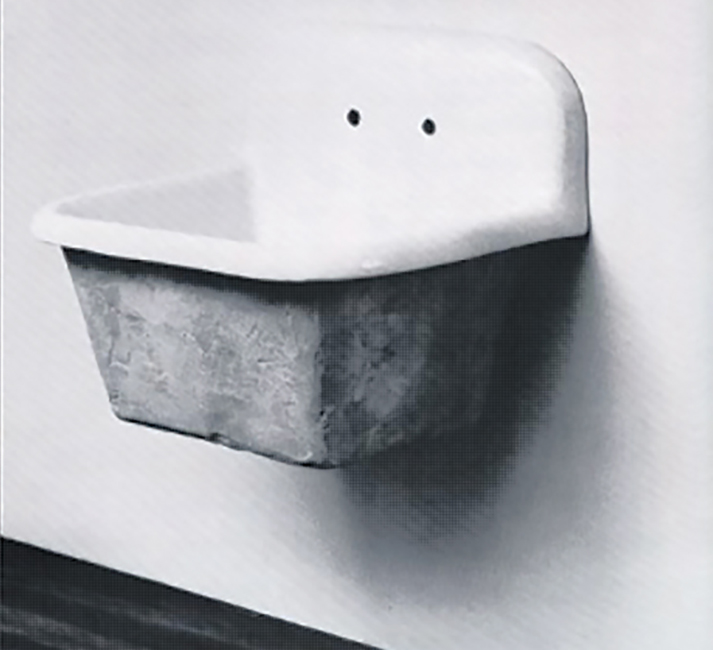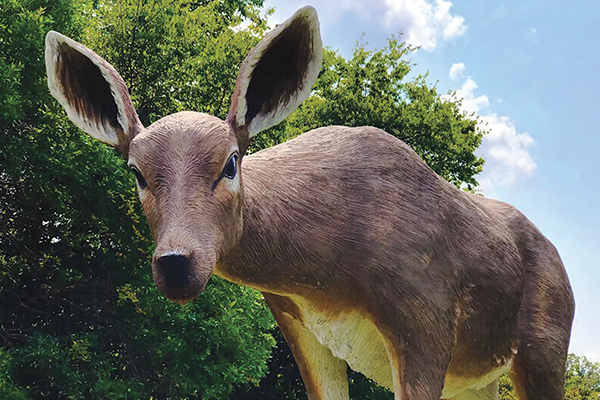French Encounters: A Family Trip Through Art and History

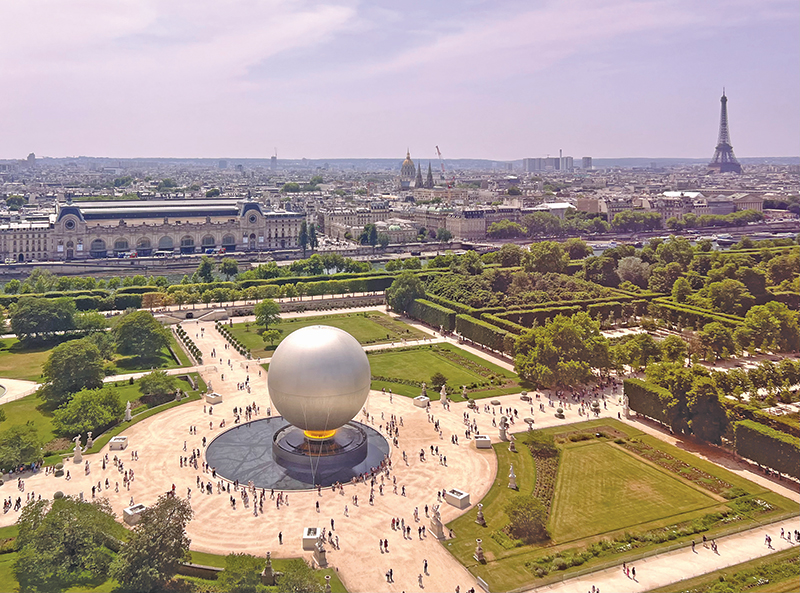
A view of Mathieu Lehanneur’s Olympic Cauldron in Paris in the Jardin des Tuileries, with the Musee D’Orsay, the Left Bank and the Eiffel Tower beyond. Photo by CGN.
By GINNY VAN ALYEA
My family and I traveled to France this summer, right after school let out, starting in Paris and winding our way down to Provence and then back to Paris. The occasion was to meet up and celebrate a dear friend’s birthday, but my planning also quickly focused on art. This was not my first time to France but it would be for our two children, who are young but also old enough to be excellent travelers. My husband and I wanted to share the highlights of a first encouter but also go beyond what we ourselves had explored previously. We visited many iconic and historic sites, but the trip offered something more: a repeated and often unplanned engagement with contemporary art in historic places. As someone who lives around and writes about art, I was attuned to these juxtapositions—but seeing them through the lens of family travel gave them a different kind of resonance.
*

The newly restored interior of Notre Dame Cathedral.
We decided to divide our time between Paris on the Left Bank, followed by a week in Provence with our friends, and two nights back in Paris on the Right Bank. It sounded like plenty of time, but while we realized quickly that there is never enough time to see it all, we still had a lot to do and enjoy.
On our first afternoon in Paris, we visited the interior of Notre-Dame Cathedral, which reopened in December 2024 following the 2019 fire. Lucky enough to grab free, timed entry tickets while still in the taxi in from the airport, we didn’t have to wait long to see the cathedral’s restoration work up close. Once inside we marveled at how the centuries old stone is clean and light, practically aglow. Outside on the river side towering crains and scaffolding show that there is more work being done to continue the restoration. The kids will never know for themselves how the fire that ravaged Notre Dame horrified the world. For me it was amazing to behold the difference before and after. After our visit a walk to ice cream on Ile St. Louis allowed us to enjoy our arrival after so much planning and to look forward to what’s next.
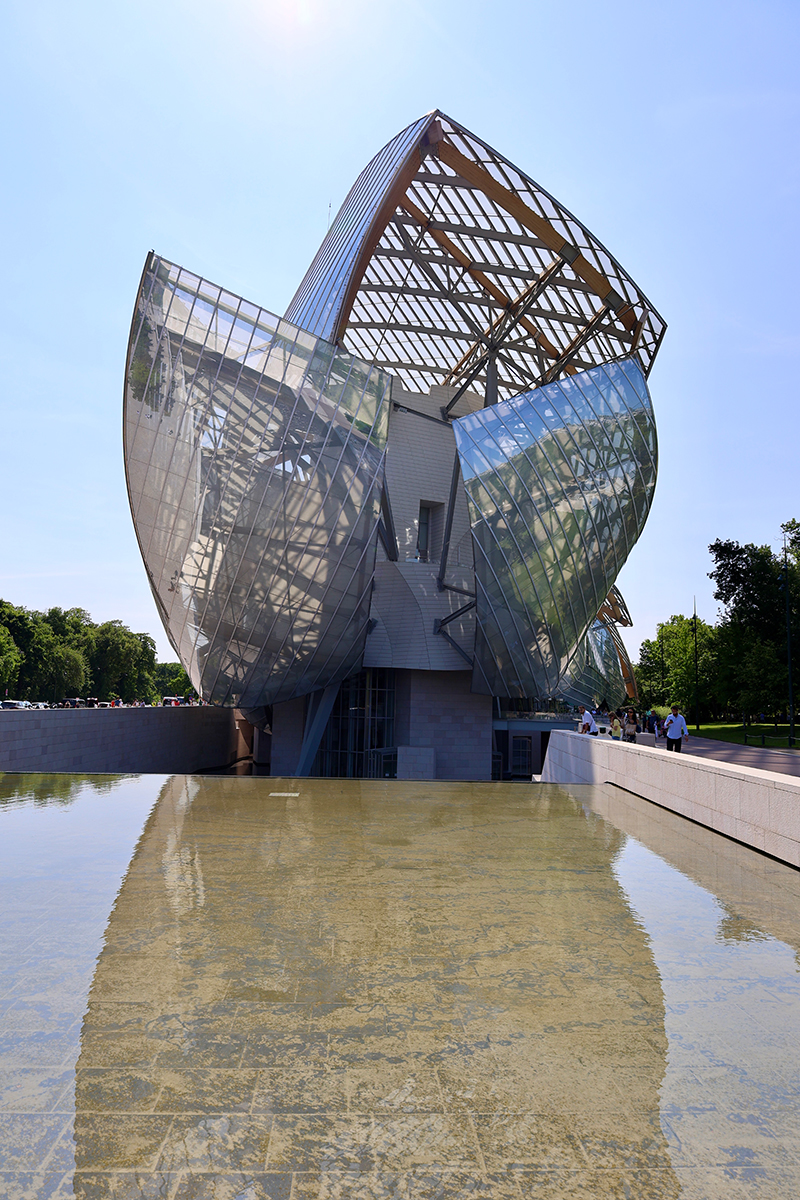
The exterior of Fondation Louis Vuitton, designed by Frank Ghery.
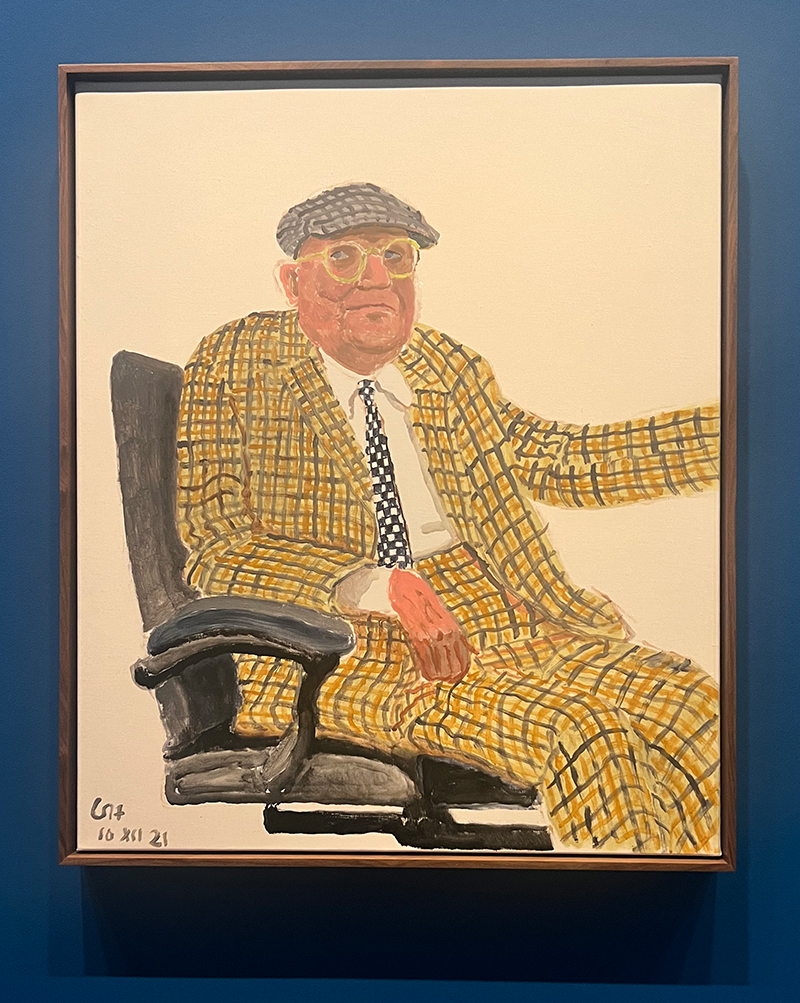
A David Hockney self-portrait

A room filled with spring images by David Hockney
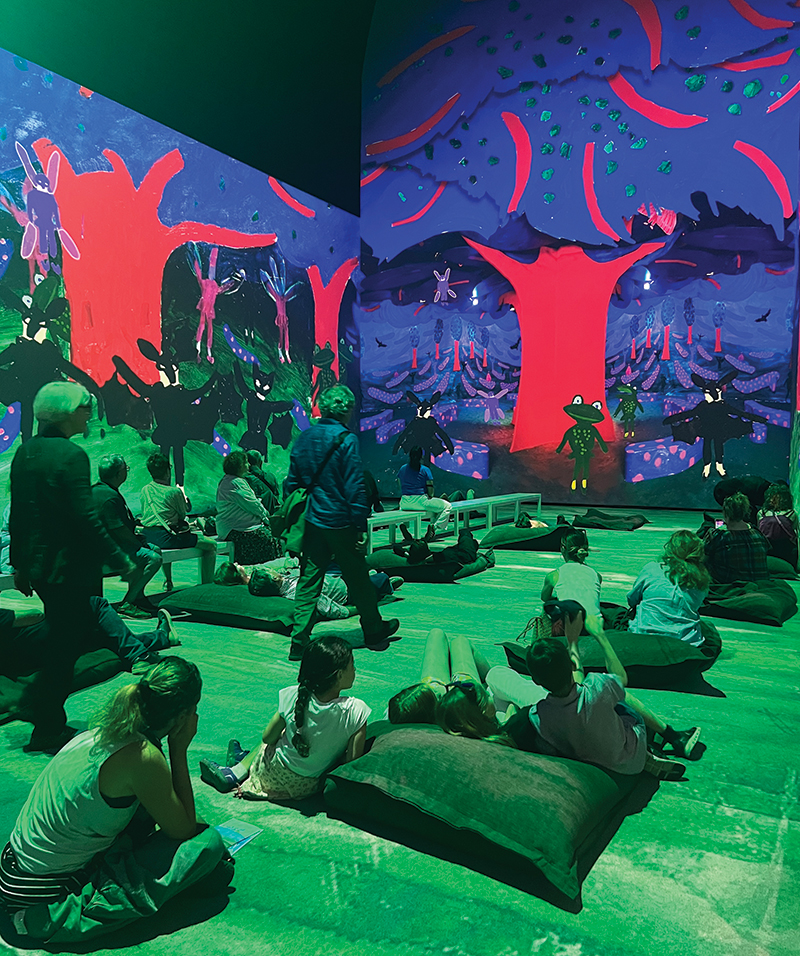
Hockney's opera sets animated in an immersive room
The next morning, we climbed to the top of the Arc de Triomphe—still one of the best views of Paris—and we spent time taking pictures as well as visiting the small museum at the top of the monument. Down on the ground again amidst the city’s famous traffic, we took the navette (shuttle) out to the Fondation Louis Vuitton in the Bois de Boulogne, where friends joined us for David Hockney 25. The Fondation’s building, designed by Frank Gehry, resembles waves or a lotus blossom. We waited in line while holding custom white umbrellas, due to the intense heat at noon, our reserved entry time. My son had protested going inside to a museum with contemporary art (I have heard this before) but in the first gallery, taking in the large, bright canvases by Hockney from the ‘60s he turned to me and said, “Oh, I actually like this art.” The kids, joined by two friends, hopped from gallery bench to bench, taking every chance to sit but also observe the crowds and admire the art. They were very interested in Hockney’s iPad landscapes and his portraits of so many different faces done in appealing, cheerful colors. The highlight, though, was the chance for the three of us to find our own giant beanbag in the darkened, long gallery featuring projections of Hockney’s opera stage designs from over the years, including one for Puccini’s Turnadot, performed at the Lyric Opera of Chicago in 1992. Looking skyward, hearing captivating music and watching saturated, moving scenes tied painting and music together in a memorable way.
After two hours in the air conditioned exhibition, we returned to the heat to unwind and find lunch nearby in the charming Jardin d’Acclimatation, an idyllic Parisian amusement park recommended by friends that offered good food, peacocks, a roller coaster, and shade. Great America this was not. The proximity of contemporary art to such a delightful outdoor destination that also appeals to children made me wish we had such a stimulating pair of sites at home.
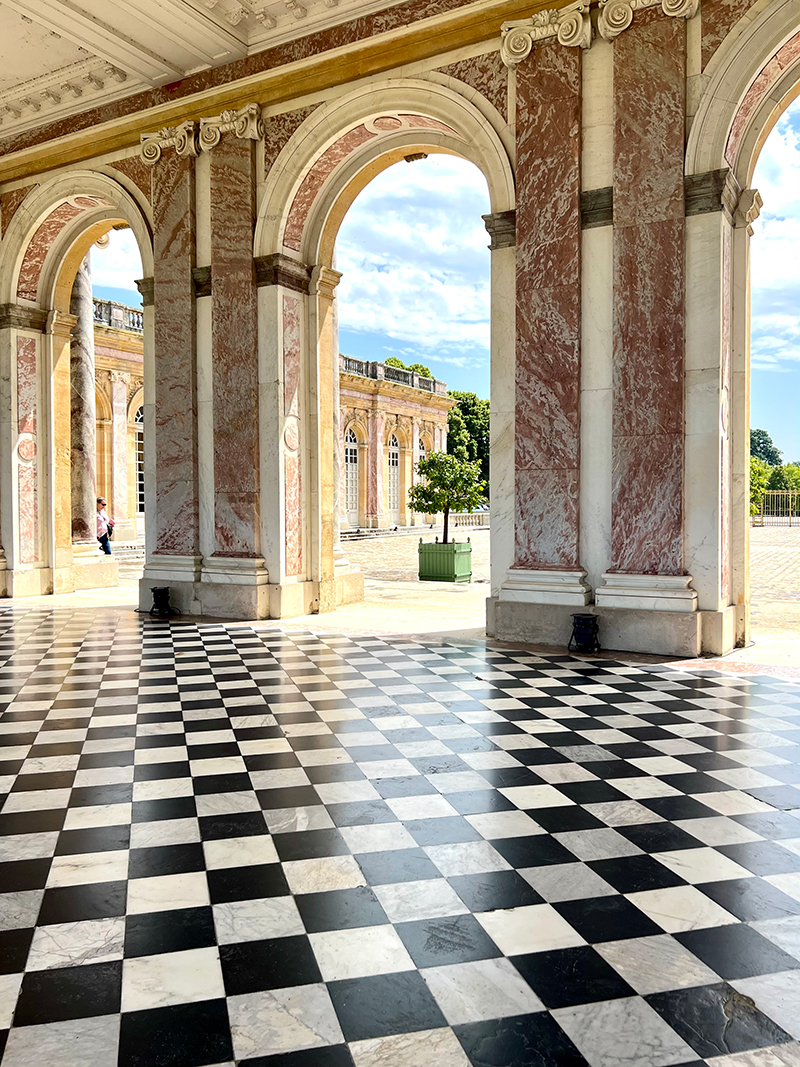
Visiting the Grand Trianon, where there were hardly any crowds.
Day three took us out to Versailles by train, where we rented bikes and explored the grounds—starting with a picnic made from provisions we picked out at the market in the town of Versailles. We took our time visiting the royal properties in reverse, first the Grand Trianon, then the Petit Trianon and Marie Antoinette’s hamlet, and ending at the main palace. After a few hours in the heat on our bikes, the children briefly marveled at the gleaming gilt all around the gates and eaves of the palace, but by the time we reached the Hall of Mirrors, we had stood too close to too many people for too long.
Our little bike group was no match for the throngs of bused-in, guided tourists who spilled in from the parking lot.
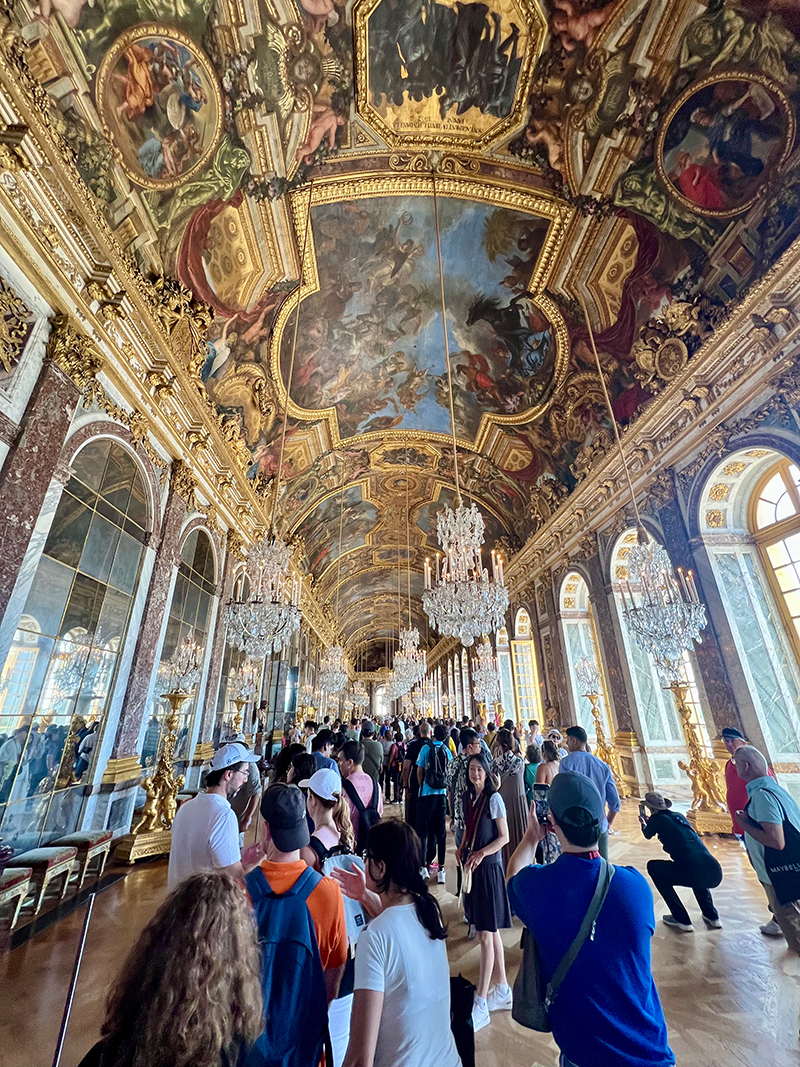
Inside the Hall of Mirrors at Versailles, where the crowd was massive.
Back in Paris that same evening, we took a long walk home after dinner and stopped to take photos by the Louvre’s now iconic glass pyramid, beautifully lit and relatively empty in the late evening. Being mid-June it was still twilight. Turning away from the Louvre’s courtyard and towards the direction of the Eiffel Tower and the Jardin des Tuileries we were delighted by the glow of Mathieu Lehanneur’s Olympic Cauldron, which has remained in place since 2024’s summer games, when it would rise 60 meters into sky and its design symbolized France’s national motto, “Liberté, égalité, fraternité”.
The cauldron is made of a 23 ft. diameter ring suspended from a helium balloon (also a hallmark of France’s innovation) The cauldron’s glow is not from actual flames but LED lights, which emit flame-like wisps because of 40 lamps backlit by mist from by 200 water jets. In a city with so many old icons, this is undoubtedly a new one.
*
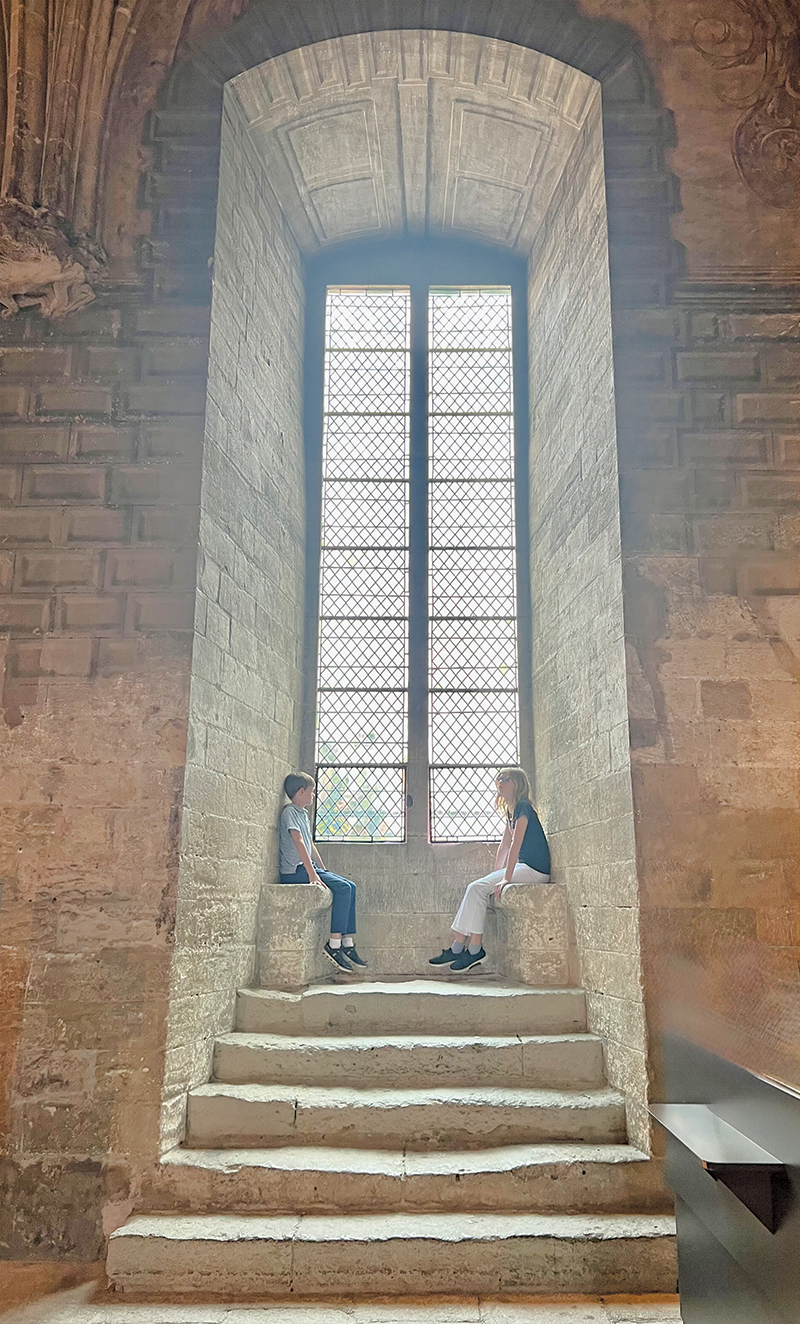
Waiting to tour the Palais des Papes
When we boarded the train to Avignon, our trip began to shift. In town the Palais des Papes, a massive Gothic structure near the Rhône river, dominates the city center. We considered a minute whether or not to buy tickets to tour the building, as the kids had been on the train or in the car for most of the day, but we were very glad we did, as we came away with quite a bit of knowledge about the time when the center of the Catholic Church was not in Rome but in France. The former fortress and palace is today a UNESCO World Heritage Site, and it was here that six papal conclaves were held in the 14th century. We also were lucky to visit the installation of work by Jean-Michel Othoniel to celebrate the 25th anniversary of the city of Avignon’s designation as European Capital of Culture and the 30th anniversary of its inclusion on the UNESCO World Heritage List. On view through January 4, 2026, OTHONIEL COSMOS or the Ghosts of Love, is an expansive, artistic immersion hailed as the artist’s largest project ever conceived and the first on a national scale, spread across 10 unique locations, with more than 260 works for Avignon. Mirrored glass sculptures, iridescent aquamarine bricks and graphic interventions animated the medieval interior. The tension between old and new wasn’t just thematic—it was spatial, visual, and palpable.
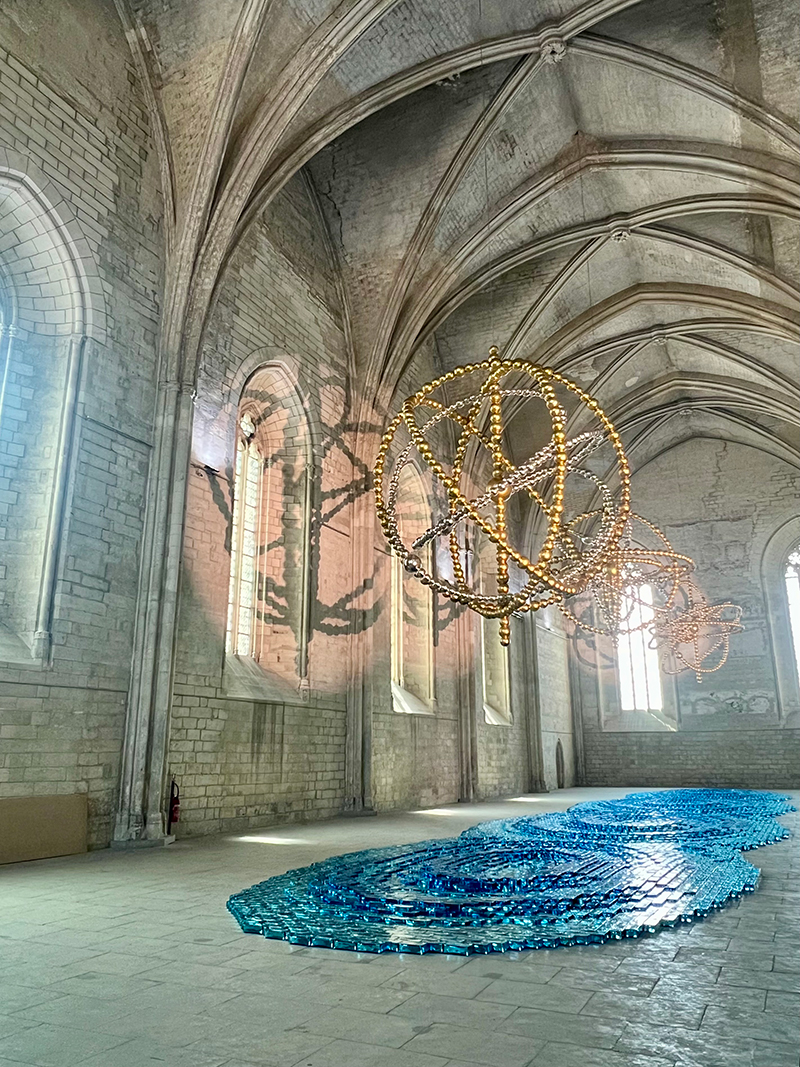
An installation by Jean-Michel Othoniel
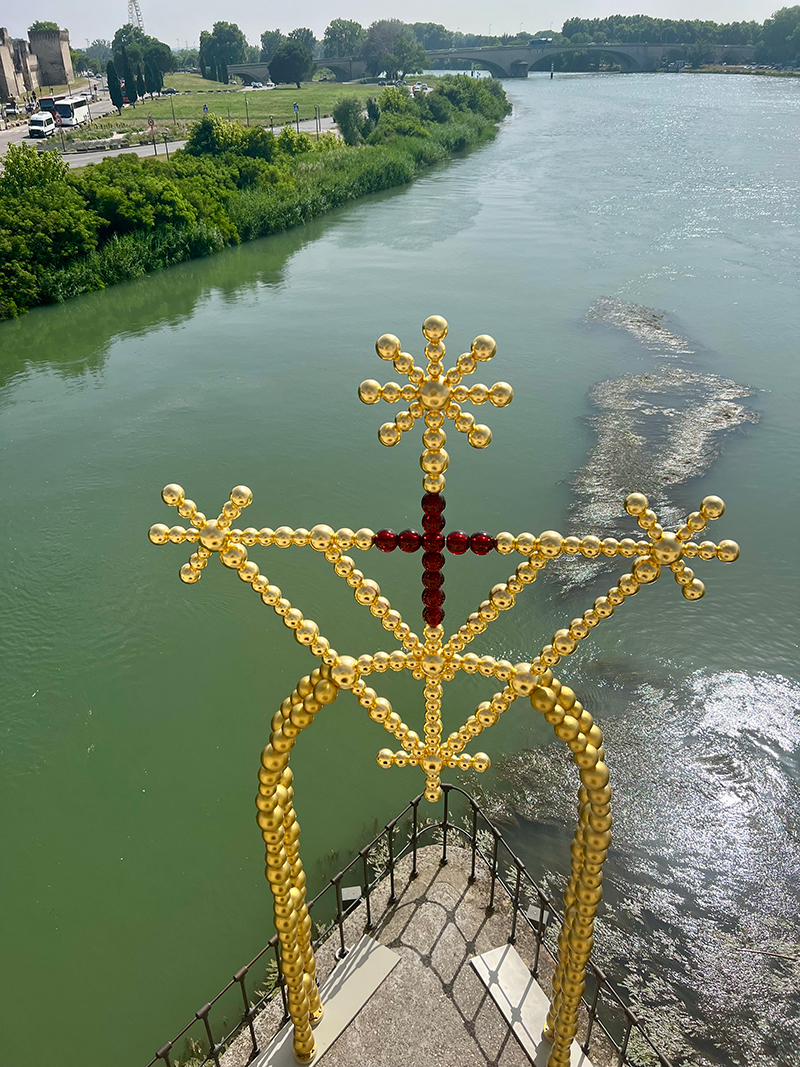
An installation by Jean-Michel Othoniel on the Pont Saint-Benezet in Avignon
The following days in Provence were spent resting a little more, adjusting to the southern pace and letting the kids recover from the more intense museum time. We still found ourselves busy each morning, setting out ahead of the heat explore the Luberon on planned trips to experience local food and culture, spontaneously jumping out to see the lavender fields or hiking around Roussillon and its Mars-like hills (where ochre, humankind’s first pigment used in art likely came from). Everywhere there was history, and there was art. We visited Château de Lourmarin, where I came across a library room featuring a collaboration between the Fondation des Treilles and the Fondation de Lourmarin Laurent-Vibert. Contemporary photography by international artists with portraits of everyday people in arresting natural settings were on display—quietly, without fanfare. The children were off on a scavenger hunt in the château with others from our group, which gave me time to enjoy the vaulted stone space uninterrupted. The town of Lourmarin itself was quirky and full of life: artisan boutiques, antiques, and a kind of layered charm you hope for in small towns but don’t always find.
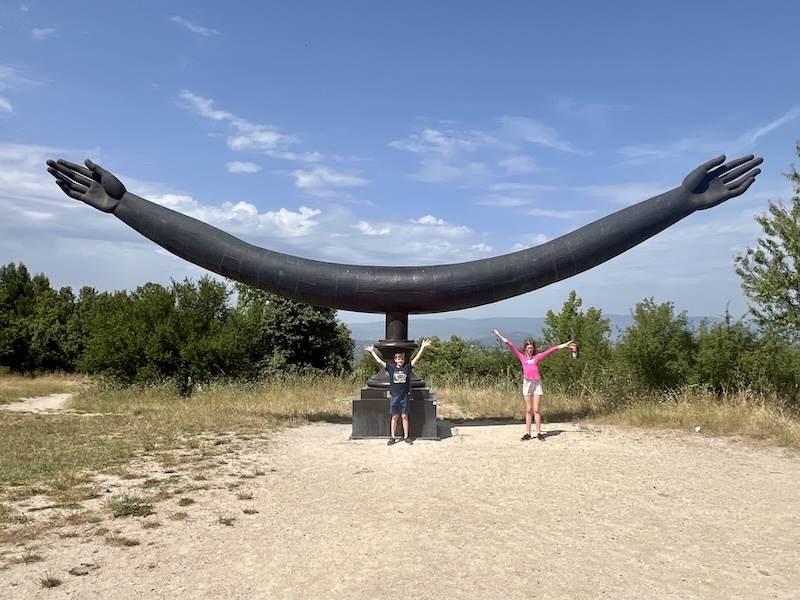
The interns posing for another photo at the top of the hill in Lacoste

A surprise installation in Lacoste
In the hilltop town of Lacoste, we wound up the stone streets overlooking the Vaucluse and to the Château that was once the home of the infamous and exiled Marquis de Sade. The Château ruins were purchased by the late fashion designer Pierre Cardin in 2001, and today there is an arts festival that takes place in the town each summer. I did not know before our visit that the Savannah College of Art and Design (SCAD) has a campus in the tiny town. Though student residents were between installations, an American art school in this Provencal village felt both surreal and fitting. I thought how nice it would be to be a student again and reside in this creative, energetic place where centuries-old architecture was inspiring 21st century textile work juxtaposed with LED sculptures. It was a serendipitous travel moment, entirely unrepeatable.
A day later on the way to Les Baux-de-Provence, we stopped at Glanum in the Alpilles, where ruins of what was once a wealthy city, including its spring and a triumphal arch, remain remarkably intact. It was a hands-on history lesson—city plans and advanced infrastructure visible in 2,000 year old stone, accessible without barriers. The kids were allowed to roam and interpret on their own. We wondered what it would have been like for citizens to abandon the walls and monuments they built by hand, stone by stone.

The Maison Carrée in Nîmes
Our last full day in Provence was spent in Nîmes, where we saw the Maison Carrée, a nearly pristine Roman temple thought to be from the 1st century AD. Opposite the temple square is the glass, steel and concrete Carré d’art, opened in 1993 and designed by British architect Norman Foster. Though the building is nine stories, half of it is below ground to maintain scale with its temple neighbor. A short walk away is the city’s famous, 2,000 year old amphitheater, which continues to host performances today. These monuments were reminders of the scale and durability of Roman urban planning—and the continued effort France invests in preserving as well as using them.
On our drive home my husband pleaded with our kids to stop one more place–no small ask since everyone was eager to return to the pool as soon as possible. We stopped at Pont du Gard, where hundreds of people swam below the aqueduct, families gathering along the riverbanks and wading into the water. There are few places I have seen where ancient engineering so seamlessly accommodates 21st-century summer vacationers.
*
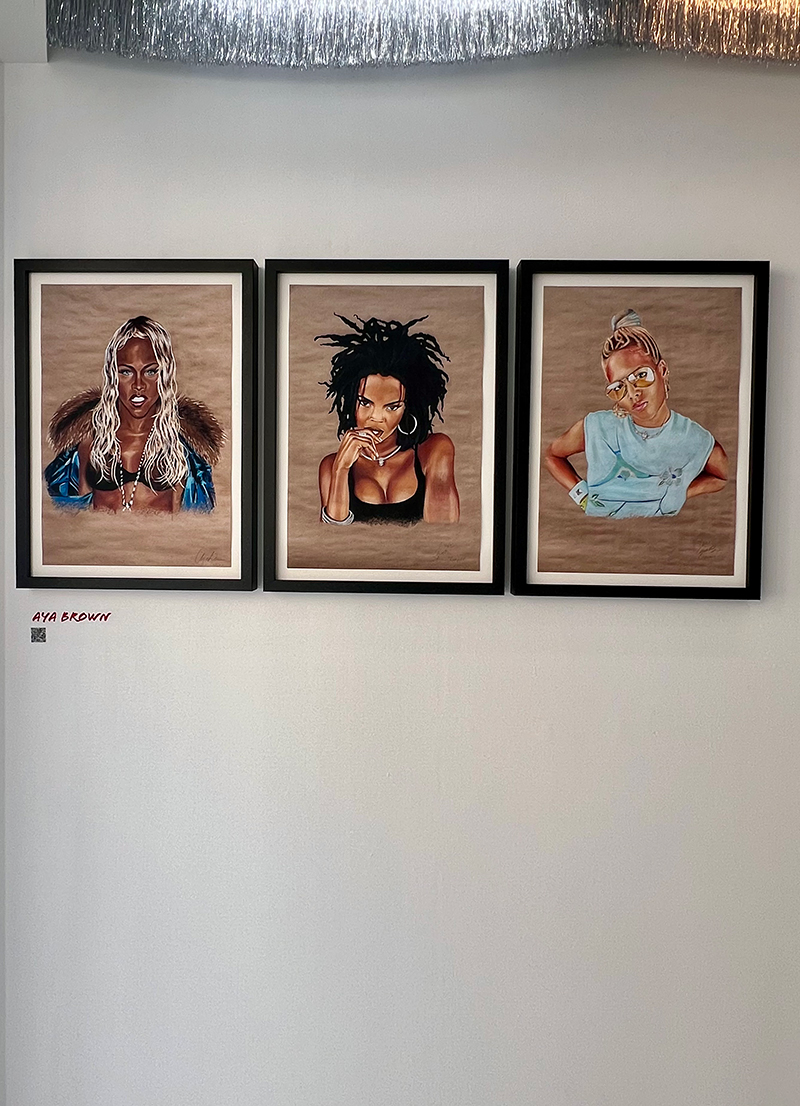
Aya Brown at Galerie Gomis in Paris
The following morning we were up early in order to catch the train back for a full day in Paris. We dropped our bags and went straight to Marche Des Enfants Rouges for lunch. We stood shoulder to shoulder with everyone else who was hot and thirsty on a Saturday afternoon and opted for a delicious Japanese meal—cool udon, ramen, and beer—and then strolled home, gelato in hand, via galleries in the Marais. I stopped into Galerie Gomis when I unexpectedly noticed Aya Brown’s work on view as part of girls! girls!! girls!!! Brown recently exhibited her prints as part of a group show at Anthony Gallery in Chicago. The connection felt like a full-circle art moment.
We made some museum choices for this trip because we had the kids along. Had it just been my husband and me we would have covered more ground. Being an introductory trip, we chose the Louvre over the Musee d’Orsay. On our last full morning in Paris, we walked to the Louvre, feeling grateful that we avoided a museum strike a few days earlier. The crowd seemed even a little lighter than usual. In the spirit of first-timing, my daughter insisted we see the Mona Lisa. We found her easily, initially thinking we were in the wrong room because the crowd was small. There was a sign posted politely reminding visitors to be respectful to gallery staff. Once we had seen the famous smile we were free to wander to see many more highlights by artists such as Delacroix, Ingres as well as The Winged Victory of Samothrace and the Egyptian antiquities in the basement. We even got to peek at France's Crown Jewels.
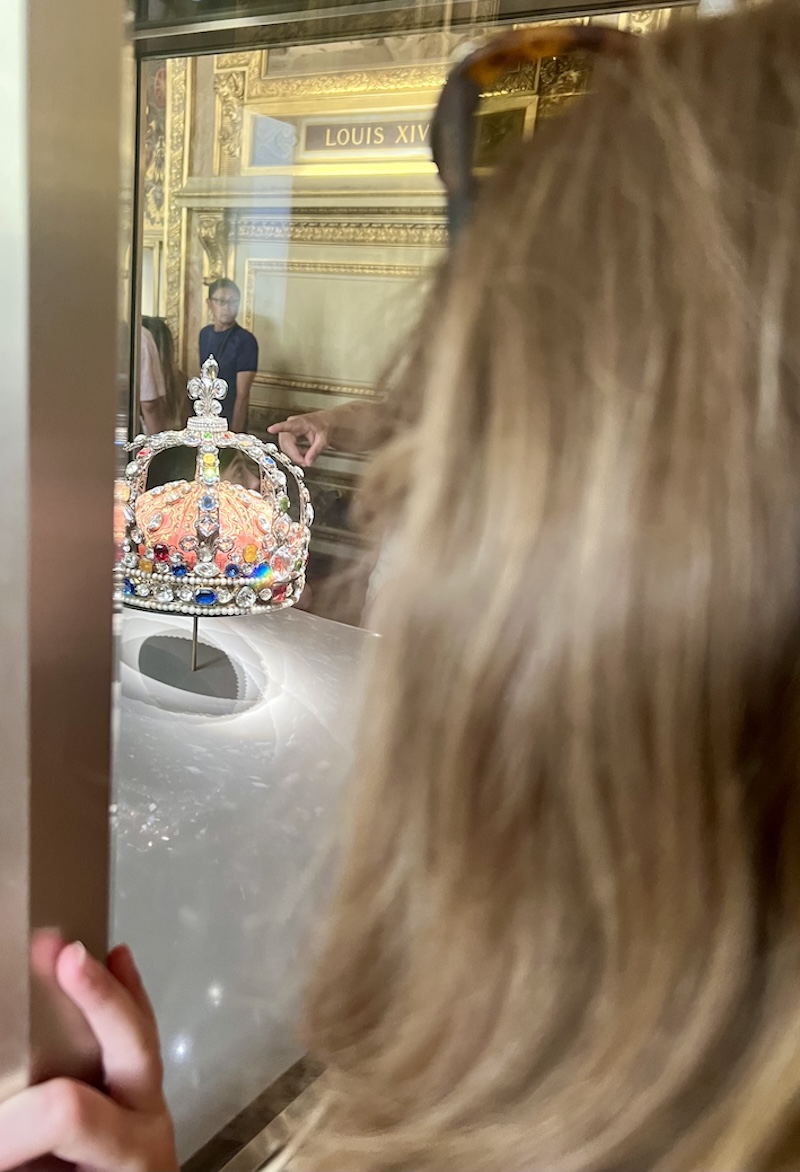
The Crown Jewels at the Louvre
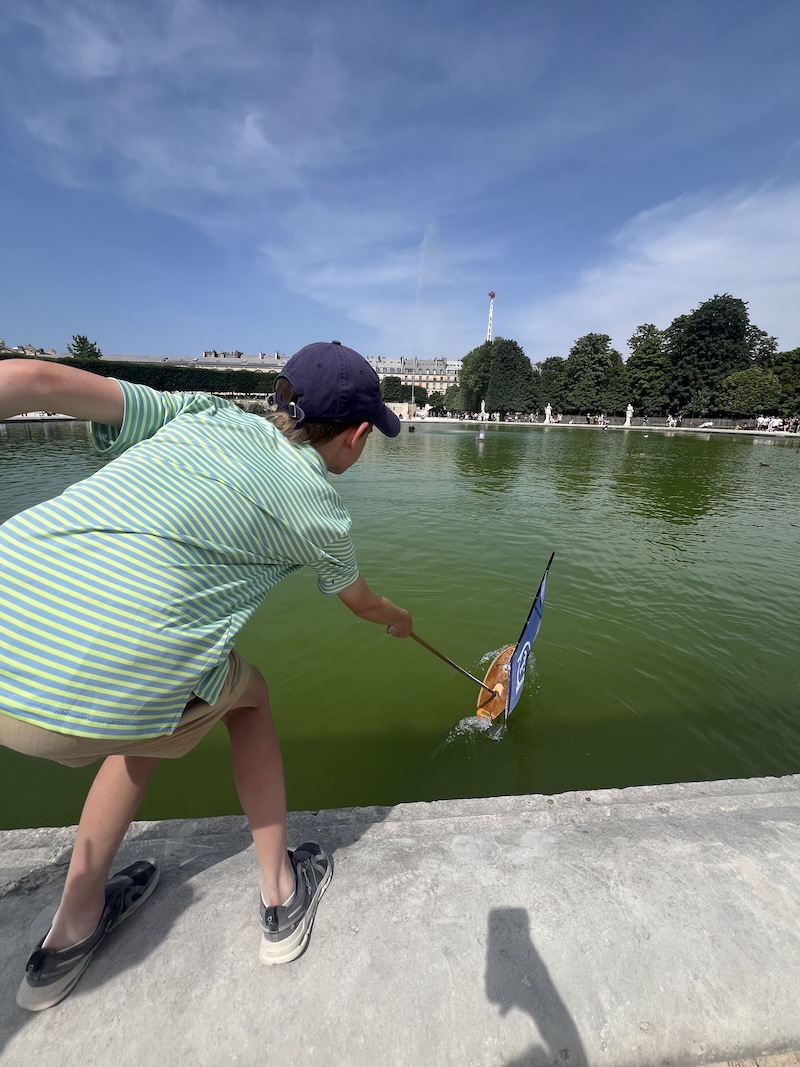
The perfect send-off on our final day in France.
One of our last quiet moments in Paris came on our final day, when we visited the Tuileries Garden and spontaneously rented a petit bateau—a little sailboat the kids pushed around the fountain with sticks. They named her Mona. The simplicity of the kids free in a park, eating gelato and people-watching, while afternoon sun reflects off the water was a reminder that delight in Paris will find you suddenly. It won’t be on a check-list or in a fancy restaurant. It can’t be planned.
That evening, after excellent Roman pizza at a tiny place in the Marais, we walked home through warm city streets, past the glowing Bourse de Commerce. We hadn’t made it inside this trip, but we knew we have more to look forward to next time.
*
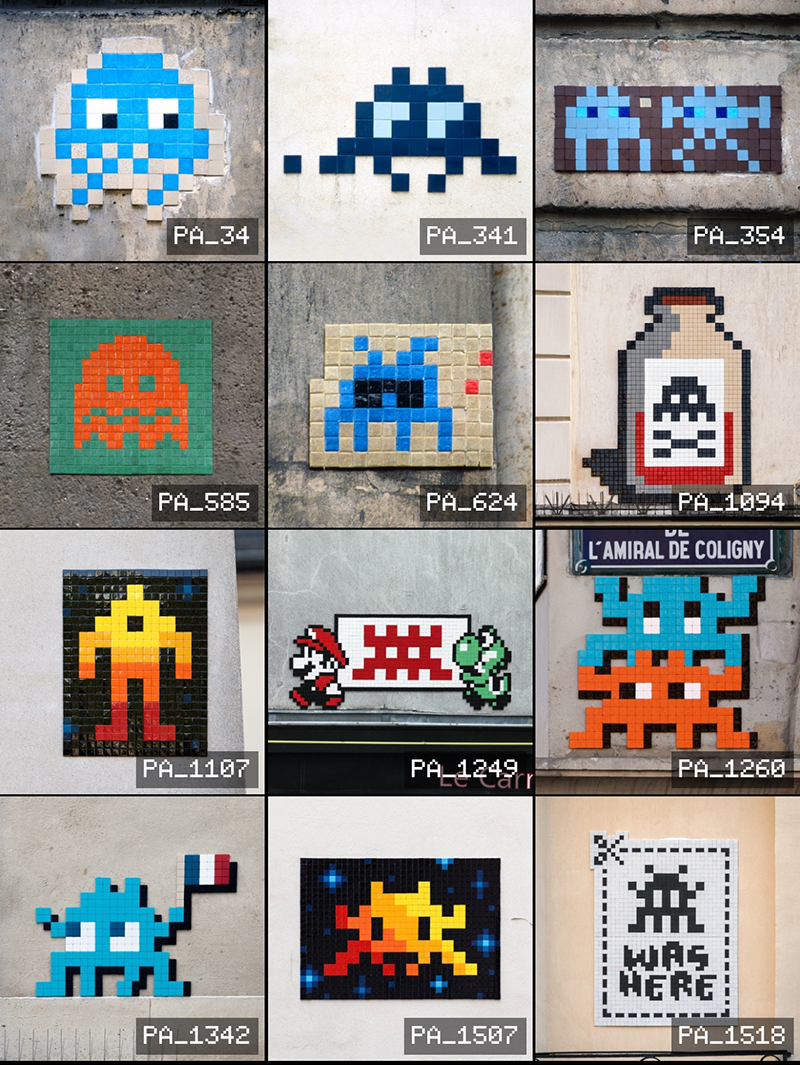
Our Invader finds
*
One more thread that ran through our adventure: before we arrived in Paris a friend recommended that we track the Invader tiles. The French street artist known as Invader has placed thousands of mosaic tile works across France (and beyond), each resembling an 8-bit alien character from the classic arcade game Space Invaders. Unlike Banksy, whose fame can overshadow the work, Invader’s pieces blend into their surroundings. You might see one tucked above a bakery, or high on a stone wall in Avignon. Our son in particular became a sharp-eyed scout, spotting Invaders everywhere—some chipped, some pristine, others invalid fakes. It was the kind of organic art experience that felt personal and earned.The discovery was better than any guided tour we could have planned or tourist trinket we could have bought.
Our family’s trip wasn’t structured just around art, but art was definitely a thru-line—everywhere from cathedrals and palaces, to gardens and châteaux, in contemporary interventions and ancient ruins. The blend of contemporary art in historic spaces wasn’t always announced. But those contrasts—between old and new, formal and spontaneous, monumental and small-scale—are what stuck with me. They reminded me that culture is a living continuum, not an itinerary or social media post.
When you travel with kids, those moments can matter most when you stumble into them together as well as at your own pace. They have the potential to leave the impression that you cannot travel without enjoying art (sorry Tommy.) In fact, art makes the trip better.
#
